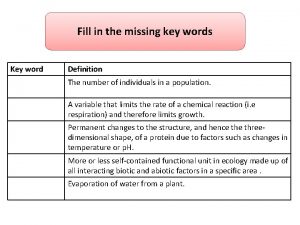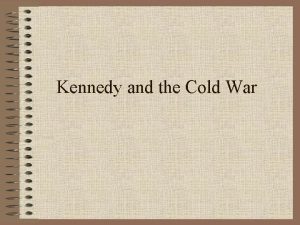Warm Up Complete the warm up Ms Kennedy














- Slides: 14

Warm Up Complete the warm up Ms. Kennedy handed to you on your way into class.

Quiz!! You have 20 minutes!!

Measures of Spread And Outliers

Measures of Spread • Differences in spread can influence interpretation of the data set • Range is a crude measure of spread • Other measures of spread: –Variance –Standard Deviation

Variability • Variability = Consistency • How consistent are the measurements? • Consider the following data sets: 24, 25, 25, 26 1, 2, 3, 47, 48, 49 • Both data sets have a mean & median of 25, but the sets are very different

Range • Range = Largest Value – Smallest Value • Crude measure of spread • Affected by outliers

Standard Deviation • Distance each data value is from the mean • Standard deviation formula is complicated: Use the calculator to compute standard deviation • Find the standard deviation for the following data: 3, 4, 5, 6, 4, 2, 0, 8, 4 Grab a calculator! Same steps as yesterday we are just looking at a different symbol, Sx.

Connie’s test scores Oscar’s test scores • • • 82, 84, 85, 86 Mean – Median – Mode – Range – Standard Deviation - • • • 72, 76, 84, 90, 94, 96 Mean – Median – Mode – Range – Standard Deviation – Which student is more consistent?

So far… We have been identifying outliers just by what we assume sticks out from the group, but we all know what happens when you assume so now lets use a formula.

To find outliers, we use 1. 5 IQR Rule 1 st: Find the IQR = Q 1 – Q 3 2 nd: Multiply your IQR by 1. 5 3 rd: Identify your limits (any value outside of these limits is an outlier) • Lower limit = Q 1 – (your value from step 2) • Upper limit = Q 3 + (your value from step 2)

Example 1: • Calculate the IQR from the data set below 87, 7, 41, 50, 15, 220, 23, 99, 11, 45, 11, 61, 3, 39, 21

You can also find if you have outliers in your calculator by creating a box plot. Step 1: Type data into L 1 Step 2: Turn your box plot on (1 st option) - 2 nd y= Enter (on, and 4 th option highlighted) Step 3: Look at the box plot - Zoom 9: Zoom. Stat

Example 2 Using your calculator identify the outlier, if there is one 59, 27, 18, 78, 61, 91, 52, 34, 54, 93, 100, 87, 85, 82, 68

Example 3: Now add a 150 to the last data set and see what your box plot looks like.
 Complete the missing word to complete the three key words
Complete the missing word to complete the three key words Complete subject and simple predicate
Complete subject and simple predicate Quá trình desamine hóa có thể tạo ra
Quá trình desamine hóa có thể tạo ra Khi nào hổ con có thể sống độc lập
Khi nào hổ con có thể sống độc lập Các châu lục và đại dương trên thế giới
Các châu lục và đại dương trên thế giới Các loại đột biến cấu trúc nhiễm sắc thể
Các loại đột biến cấu trúc nhiễm sắc thể Thế nào là sự mỏi cơ
Thế nào là sự mỏi cơ Bổ thể
Bổ thể Phản ứng thế ankan
Phản ứng thế ankan Thiếu nhi thế giới liên hoan
Thiếu nhi thế giới liên hoan Hát lên người ơi alleluia
Hát lên người ơi alleluia điện thế nghỉ
điện thế nghỉ Vẽ hình chiếu vuông góc của vật thể sau
Vẽ hình chiếu vuông góc của vật thể sau Một số thể thơ truyền thống
Một số thể thơ truyền thống Hệ hô hấp
Hệ hô hấp



























